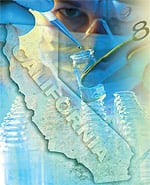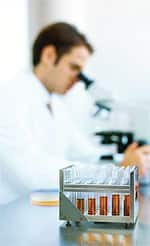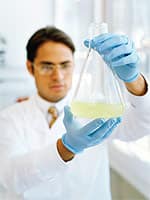Life Extension Magazine®
Life Extension® started recommending DHEA to members in 1981 and pregnenolone in 1996. Our review of the scientific literature decades ago indicated that when used appropriately, these bioidentical hormones may slow the onset of multiple degenerative diseases and sustain optimal cognitive function in maturing individuals. Since then, an armada of published studies has validated our position. Just last year, there were 380 newly published papers about DHEA.1 This wealth of incontrovertible medical evidence has not stopped the government from erecting regulatory barriers that would deny you the ability to replenish DHEA and pregnenolone to youthful levels. What you need to know
The latest governmental assault comes out of California. The sale of DHEA and pregnenolone is now illegal unless accompanied by a fear-mongering, scientifically baseless warning label. We think the State of California should have consulted enlightened, reputable scientists before imposing such onerous statutory burdens. In this instance, this legislative mandate only serves to misinform and frighten the public about the health-promoting properties of hormones made by our own bodies. Once again, it is time to set the record straight regarding the medically established benefits of DHEA and pregnenolone. The infinite wisdom of elected lawmakers in California has spawned a questionable dictate. While few if any of these legislators have any direct experience with DHEA or pregnenolone, they nonetheless have issued a decree that all labels must carry a warning. The warning is so strong that novices who read these labels will fear DHEA and pregnenolone and not use them. That’s too bad since hard science substantiates both the safety and efficacy of these natural hormones. Life Extension’s medical experts reviewed California’s label information, and our assessment of the peer-reviewed literature differs in certain important respects from the conclusions reached by State legislators. The law, Section 110423(b) of the California Health and Safety Code, states, “The sale or distribution of dietary supplements containing steroid hormone precursors is prohibited unless the product label for the dietary supplements clearly, and conspicuously contains the following warning: WARNING: NOT FOR USE BY INDIVIDUALS UNDER THE AGE OF 18 YEARS. DO NOT USE IF PREGNANT OR NURSING. Consult a physician or licensed qualified healthcare professional before using this product if you have, or have a family history of, breast cancer, prostate cancer, prostate enlargement, heart disease, low “good” cholesterol (HDL), or if you are using any other dietary supplement, prescription drug, or over-the-counter drug. Do not exceed recommended serving. Exceeding recommended serving may cause serious adverse health effects. Possible side effects include acne, hair loss, hair growth on the face (in women), aggressiveness, irritability, and increased levels of estrogen. Discontinue use and call a physician or licensed qualified healthcare professional immediately if you experience rapid heartbeat, dizziness, blurred vision, or other similar symptoms. KEEP OUT OF REACH OF CHILDREN. Separate cautions for pregnenolone must now include the statements that: “Pregnenolone may affect levels of other hormones, such as progesterone, estrogen, testosterone, and/or DHEA. Do not take this product if you have a history of seizures. Do not take this product if you have breast cancer, prostate cancer, or other hormone-sensitive diseases.” And the caution for DHEA now must read, “Do not use DHEA if you are at risk for or have been diagnosed as having any type of hormonal cancer, such as prostate or breast cancer.” The published literature on DHEA and pregnenolone as supplements paints a rather different picture. Supplementation with DHEA and/or Pregnenolone—The Scientific TruthCancer Risk
Both pregnenolone and DHEA are “parent” hormones of the sex hormones estrogen, progesterone, and testosterone. Taking pregnenolone or DHEA supplements, therefore, may indeed raise levels of those sex hormones; in fact, that is considered one of the desired effects. Mainstream physicians, however, continue to express concern about boosting sex hormone levels late in life, citing the theoretical risk of hormone-dependent malignancies such as breast and prostate cancers. The truth, as always, is more nuanced. Important work by Harvard urologist Abraham Morgentaler and others has revealed that low testosterone levels increase prostate cancer risk.2,3 Morgentaler himself has become a strong proponent of supplementation with testosterone in older men.3 He was also the lead researcher on a study demonstrating that DHEA supplementation in rats enhanced total testosterone levels without producing any deleterious changes in prostate tissue.4 Similar theoretical risks apply for breast cancer. But no increased risk of breast cancer has been demonstrated in large studies of combinations of natural estradiol and progesterone (the natural products of DHEA and/or pregnenolone).5 Furthermore, natural progesterone alone may reduce cancer risk, again suggesting that boosting sex hormone levels with precursors such as DHEA and pregnenolone is safe.6 One recent animal study demonstrates a direct anti-cancer effect of DHEA in obese rats.7 To date, no study has convincingly shown an increase in human hormone-dependent cancer risk as a result of DHEA or pregnenolone supplementation.8 Naturally, any individual who is known to have cancer of any kind should consult with his/her physician when using any new supplement or medication. Heart Disease or Low HDLOne of the most perplexing features of the California label requirement is the caution about a family history of heart disease or low high-density lipoprotein (HDL) cholesterol. DHEA is in fact known to decrease cardiovascular risk factors by improving vascular remodeling in the face of high blood pressure, improving insulin sensitivity and reducing obesity, and increasing HDL levels.9-12 No studies have been published demonstrating that pregnenolone raises any cardiovascular risk factors. Rapid Heartbeat, Dizziness, or Blurred Vision
The California label requirement explicitly warns against continuing supplementation in the face of rapid heartbeat, dizziness, blurred vision, or other “similar symptoms.” This, like the general cardiovascular precaution, is mystifying in the face of the published literature. There are no published, peer-reviewed articles suggesting that either DHEA or pregnenolone supplements are associated with rapid heartbeat, tachycardia, or atrial or ventricular fibrillation. In fact, men with atrial fibrillation were shown in one study to have abnormally low DHEA levels.13 Similarly, there is no published report of either DHEA or pregnenolone in association with any visual disturbance or glaucoma. Just two reports exist on age-related macular degeneration and DHEA levels. The older one suggests that higher DHEA levels might be associated with increased risk, but the more recent article demonstrates a protective effect of higher DHEA levels.14,15 And a single French study demonstrated that higher DHEA levels are associated with reduced risk of cataracts.16 Just one study, from 1998, shows in an animal study that pregnenolone produces an excitatory effect on nerve cells in the inner ear, where balance is maintained.17 This could produce a theoretical risk of dizziness or vertigo, but no report of such an effect in humans has been published.
VirilizationBecause both DHEA and pregnenolone boost natural levels of testosterone as well as estrogen, there is some concern that women who take the supplements might express more masculine traits such as male pattern baldness, hair growth on the face, and aggressive behaviors. In practice, however, these effects appear infrequently and are mild and reversible when they do occur.18,19 A sensible recommendation for anyone taking DHEA or pregnenolone is to monitor oneself for any of these mild side effects, and to discontinue use or reduce dose if those effects outweigh the benefits of continued supplementation.
Seizure HistorySome of the beneficial neurosteroid effects of pregnenolone result from an increased activity of brain cells. But in people with known seizure disorders (epilepsy), and in animal studies where the steroid is directly injected into the brain, this effect can lower the seizure threshold and make a seizure more likely.20-24 There are no published studies, however, suggesting an increased risk of seizures from pregnenolone supplementation in humans without a prior seizure history.
SummaryCalifornia’s warning label requirement significantly overstates any risks associated with DHEA and pregnenolone as supplements. Despite the dire wording on the required label, there remains no convincing evidence that either supplement, taken at recommended doses, increases cancer risks in humans. The other risks mentioned in the required warning label either occur rarely or are reversible (hair growth), occur in well-defined populations who should avoid using the supplements (seizure patients), or have no credible basis in the peer-reviewed literature (cardiovascular risk, lipid disturbances, vision disturbances, dizziness). On the other hand, millions of people worldwide have been using both supplements for more than two decades, during which time no serious adverse events have ever been reported in the world literature or in the FDA’s intense adverse event monitoring system.11 Readers should understand that the cautions on labels of DHEA and pregnenolone supplements reflect an “abundance of caution” on the part of the California rule-makers…or perhaps the wishes of pharmaceutical lobbyists who fear too many people are protecting themselves against age-related disease by maintaining youthful hormone balances. The overwhelming evidence in the global, peer-reviewed literature suggests exactly the opposite, namely that these supplements are safe and effective when used as directed by health-conscious adults. If you have any questions on the scientific content of this article, please call a Life Extension® Wellness Specialists at 1-866-864-3027.
|
|||||||||||
| References | |||||||||||
|
1. Available at: http://www.ncbi.nlm.nih.gov/pubmed?term=dehydroepiandrosterone%20. Accessed April 28, 2011. 2. Morgentaler A. Turning conventional wisdom upside-down: Low serum testosterone and high-risk prostate cancer. Cancer. 2011 Mar 1. 3. Morgentaler A, Lipshultz LI, Bennett R, Sweeney M, Avila D Jr., Khera M. Testosterone therapy in men with untreated prostate cancer. J Urol. 2011 Feb 18. 4. Rhoden EL, Gobbi D, Rhoden CR, et al. Effects of chronic administration of dehydroepiandrosterone on serum testosterone levels and prostatic tissue in rats. J Urol. 2003 Nov;170(5):2101-3. 5. Mueck AO, Seeger H, Buhling KJ. Use of dydrogesterone in hormone replacement therapy. Maturitas. 2009 Dec;65 Suppl 1:S51-60. 6. Seeger H, Mueck AO. Are the progestins responsible for breast cancer risk during hormone therapy in the postmenopause? Experimental vs. clinical data. J Steroid Biochem Mol Biol. 2008 Mar;109(1-2):11-5. 7. Hakkak R, Shaaf S, Jo CH, MacLeod S, Korourian S. Dehydroepiandrosterone intake protects against 7,12-dimethylbenz(a)anthracene-induced mammary tumor development in the obese Zucker rat model. Oncol Rep. 2010 Aug;24(2):357-62. 8. Krysiak R, Frysz-Naglak D, Okopień B. Current views on the role of dehydroepiandrosterone in physiology, pathology and therapy. Pol Merkur Lekarski. 2008 Jan;24(139):66-71. 9. Dumas de la Roque E, Savineau JP, Bonnet S. Dehydroepiandrosterone: A new treatment for vascular remodeling diseases including pulmonary arterial hypertension. Pharmacol Ther. 2010 May;126(2):186-99. 10. Haffner SM, Valdez RA. Endogenous sex hormones: impact on lipids, lipoproteins, and insulin. Am J Med. 1995 Jan 16;98(1A):40S-47S. 11. Labrie F. DHEA, important source of sex steroids in men and even more in women. Prog Brain Res. 2010;182:97-148. 12. Sanchez J, Perez-Heredia F, Priego T, et al. Dehydroepiandrosterone prevents age-associated alterations, increasing insulin sensitivity. J Nutr Biochem. 2008 Dec;19(12):809-18. 13. Ravaglia G, Forti P, Maioli F, et al. Dehydroepiandrosterone-sulfate serum levels and common age-related diseases: results from a cross-sectional Italian study of a general elderly population. Exp Gerontol. 2002 May;37(5):701-12. 14. Defay R, Pinchinat S, Lumbroso S, Sutan C, Delcourt C. Sex steroids and age-related macular degeneration in older French women: the POLA study. Ann Epidemiol. 2004 Mar;14(3):202-8. 15. Tamer C, Oksuz H, Sogut S. Serum dehydroepiandrosterone sulphate level in age-related macular degeneration. Am J Ophthalmol. 2007 Feb;143(2):212-16. 16. Defay R, Pinchinat S, Lumbroso S, Sultan C, Papoz L, Delcourt C. Relationships between hormonal status and cataract in french postmenopausal women: the POLA study. Ann Epidemiol. 2003 Oct;13(9):638-44. 17. Yamamoto T, Yamanaka T, Miyahara H, Matsunaga T. The neurosteroid pregnenolone sulfate excites medial vestibular nucleus neurons. Acta Otolaryngol Suppl. 1998;533:22-5. 18. Rommler A. Adrenopause and dehydroepiandrosterone: pharmacological therapy versus replacement therapy. Gynakol Geburtshilfliche Rundsch. 2003 Apr;43(2):79-90. 19. van Vollenhoven RF. Dehydroepiandrosterone for the treatment of systemic lupus erythematosus. Expert Opin Pharmacother. 2002 Jan;3(1):23-31. 20. Reddy DS. Neurosteroids: endogenous role in the human brain and therapeutic potentials. Prog Brain Res. 2010;186:113-37. 21. Reddy DS, Kulkarni SK. Proconvulsant effects of neurosteroids pregnenolone sulfate and dehydroepiandrosterone sulfate in mice. Eur J Pharmacol. 1998 Mar 12;345(1):55-9. 22. Kokate TG, Juhng KN, Kirkby RD, Llamas J, Yamaguchi S, Rogawski MA. Convulsant actions of the neurosteroid pregnenolone sulfate in mice. Brain Res. 1999 Jun 12;831(1-2):119-24. 23. Maciejak P, Czlonkowska AI, Bidzinski A, et al. Pregnenolone sulfate potentiates the effects of NMDA on hippocampal alanine and dopamine. Pharmacol Biochem Behav. 2004 Aug;78(4):781-6. 24. Williamson J, Mtchedlishvili Z, Kapur J. Characterization of the convulsant action of pregnenolone sulfate. Neuropharmacology. 2004 May;46(6):856-64. 25. Perrini S, Laviola L, Natalicchio A, Giorgino F. Associated hormonal declines in aging: DHEAS. J Endocrinol Invest. 2005;28(3 Suppl):85-93. 26. Johnson MD, Bebb RA, Sirrs SM. Uses of DHEA in aging and other disease states. Ageing Res Rev. 2002 Feb;1(1):29-41. 27. Bischoff-Ferrari HA, Orav EJ, Dawson-Hughes B. Additive benefit of higher testosterone levels and vitamin D plus calcium supplementation in regard to fall risk reduction among older men and women. Osteoporos Int. 2008 Sep;19(9):1307-14. 28. Enomoto M, Adachi H, Fukami A, et al. Serum dehydroepiandrosterone sulfate levels predict longevity in men: 27-year follow-up study in a community-based cohort (Tanushimaru study). J Am Geriatr Soc. 2008 Jun;56(6):994-8. 29. Genazzani AR, Pluchino N, Begliuomini S, et al. Long-term low-dose oral administration of dehydroepiandrosterone modulates adrenal response to adrenocorticotropic hormone in early and late postmenopausal women. Gynecol Endocrinol. 2006 Nov;22(11):627-35. 30. Forsblad-d’Elia H, Carlsten H, Labrie F, Konttinen YT, Ohlsson C. Low serum levels of sex steroids are associated with disease characteristics in primary Sjogren’s syndrome; supplementation with dehydroepiandrosterone restores the concentrations. J Clin Endocrinol Metab. 2009 Jun;94(6):2044-51. 31. Weiss EP, Shah K, Fontana L, Lambert CP, Holloszy JO, Villareal DT. Dehydroepiandrosterone replacement therapy in older adults: 1- and 2-y effects on bone. Am J Clin Nutr. 2009 May;89(5):1459-67. 32. Kenny AM, Boxer RS, Kleppinger A, Brindisi J, Feinn R, Burleson JA. Dehydroepiandrosterone combined with exercise improves muscle strength and physical function in frail older women. J Am Geriatr Soc. 2010 Sep;58(9):1707-14. 33. Binello E, Gordon CM. Clinical uses and misuses of dehydroepiandrosterone. Curr Opin Pharmacol. 2003 Dec;3(6):635-41. 34. Buvat J. Androgen therapy with dehydroepiandrosterone. World J Urol. 2003 Nov;21(5):346-55. 35. Stomati M, Monteleone P, Casarosa E, et al. Six-month oral dehydroepiandrosterone supplementation in early and late postmenopause. Gynecol Endocrinol. 2000 Oct;14(5):342-63. 36. Leskiewicz M, Jantas D, Budziszewska B, Lason W. Excitatory neurosteroids attenuate apoptotic and excitotoxic cell death in primary cortical neurons. J Physiol Pharmacol. 2008 Sep;59(3):457-75. 37. Schlienger JL, Perrin AE, Goichot B. DHEA: an unknown star. Rev Med Interne. 2002 May;23(5):436-46. 38. Roglio I, Bianchi R, Gotti S, et al. Neuroprotective effects of dihydroprogesterone and progesterone in an experimental model of nerve crush injury. Neuroscience. 2008 Aug 26;155(3):673-85. 39. Yamada S, Akishita M, Fukai S, et al. Effects of dehydroepiandrosterone supplementation on cognitive function and activities of daily living in older women with mild to moderate cognitive impairment. Geriatr Gerontol Int. 2010 Oct;10(4):280-7. 40. Shirakawa H, Katsuki H, Kume T, Kaneko S, Akaike A. Pregnenolone sulphate attenuates AMPA cytotoxicity on rat cortical neurons. Eur J Neurosci. 2005 May;21(9):2329-35. 41. Wojtal K, Trojnar MK, Czuczwar SJ. Endogenous neuroprotective factors: neurosteroids. Pharmacol Rep. 2006 May-Jun;58(3):335-40. 42. Jo DH, Abdallah MA, Young J, Baulieu EE, Robel P. Pregnenolone, dehydroepiandrosterone, and their sulfate and fatty acid esters in the rat brain. Steroids. 1989 Sep;54(3):287-97. 43. Mayo W, Lemaire V, Malaterre J, et al. Pregnenolone sulfate enhances neurogenesis and PSA-NCAM in young and aged hippocampus. Neurobiol Aging. 2005 Jan;26(1):103-14. 44. Marx CE, Keefe RS, Buchanan RW, et al. Proof-of-concept trial with the neurosteroid pregnenolone targeting cognitive and negative symptoms in schizophrenia. Neuropsychopharmacology. 2009 Jul;34(8):1885-903. 45. Osuji IJ, Vera-Bolanos E, Carmody TJ, Brown ES. Pregnenolone for cognition and mood in dual diagnosis patients. Psychiatry Res. 2010 Jul 30;178(2):309-12. 46. Ritsner MS. Pregnenolone, dehydroepiandrosterone, and schizophrenia: alterations and clinical trials. CNS Neurosci Ther. 2010 Spring;16(1):32-44. 47. Ritsner MS, Gibel A, Shleifer T, et al. Pregnenolone and dehydroepiandrosterone as an adjunctive treatment in schizophrenia and schizoaffective disorder: an 8-week, double-blind, randomized, controlled, 2-center, parallel-group trial. J Clin Psychiatry. 2010 Oct;71(10):1351-62. 48. Khalsa DS. Integrated medicine and the prevention and reversal of memory loss. Altern Ther Health Med. 1998 Nov;4(6):38-43. 49. Vallee M, Mayo W, Le Moal M. Role of pregnenolone, dehydroepiandrosterone and their sulfate esters on learning and memory in cognitive aging. Brain Res Brain Res Rev. 2001 Nov;37(1-3):301-12. 50. Akan P, Kizildag S, Ormen M, Genc S, Oktem MA, Fadiloglu M. Pregnenolone protects the PC-12 cell line against amyloid beta peptide toxicity but its sulfate ester does not. Chem Biol Interact. 2009 Jan 15;177(1):65-70. 51. Meieran SE, Reus VI, Webster R, Shafton R, Wolkowitz OM. Chronic pregnenolone effects in normal humans: attenuation of benzodiazepine-induced sedation. Psychoneuroendocrinology. 2004 May;29(4):486-500. 52. Oberbeck R, Kobbe P. Dehydroepiandrosterone (DHEA): a steroid with multiple effects. Is there any possible option in the treatment of critical illness? Curr Med Chem. 2010;17(11):1039-47. |






